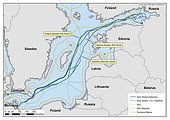Next Step in the Potential Extension of Nord Stream
Potential extension of the Nord Stream Pipeline by one or two additional lines crossed another hurdle on October 8
Oct. 8, 2012 | Zug, Switzerland | The Nord Stream Shareholders’ Committee convened at Portovaya Bay, Russia, the starting point of the twin pipeline system to mark the occasion of the flow of gas through Line 2. The Committee reviewed the outcomes of the feasibility study for the potential extension, and acknowledged the conclusions therein.
The feasibility study confirmed that the extension of Nord Stream with one or two additional lines is possible from the technical, environmental, permitting and financing perspectives. Several route options were assessed as the basis for further research, development and optimisation. The study also identified additional import needs in the long-term development of the European gas market.
The Committee agreed that any further project development should be executed within the framework of a new company to be incorporated within the first quarter of 2013. This decision was based on the benchmark set of the current Nord Stream project. The shareholders will decide their participation by that time.
In the extension feasibility study Nord Stream AG developed three main route corridor options (see the attached map), which include several areas to be studied and optimised further. In particular in the Gulf of Finland and in the Baltic Proper there are three main route corridor options: through the Finnish EEZ to the Swedish EEZ; through the Estonian EEZ to the Swedish EEZ; through the Estonian EEZ to the Latvian EEZ and then to the Swedish EEZ. The options shall be investigated further based on reconnaissance level surveys, environmental impact assessments and stakeholder feedback, and shall lead to a final route proposal. Nord Stream AG has already applied for survey permits in several countries to commence with further investigations of the proposed corridor options for an optimised pipeline routing.





